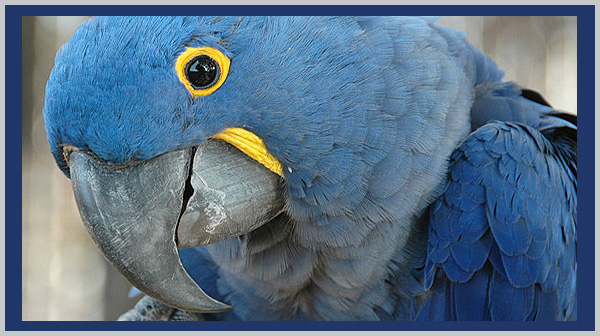
Blue Hyacinth Macaw
Name: Blue Hyacinth Macaw (Anodorhynchus hyacinthinus)
Conservation Status: Vulnerable (2021 IUCN Red List)
Population Estimate: 4,300 Mature Individuals
Range: Bolivia / Brazil / Paraguay
Threats: Agriculture / Hunting / Housing / Farming / Pulp Plantations
Many people are familiar with macaws and parrots as pet store animals. It might be difficult, then, for people to imagine what these large, loud, beautiful birds look like in the wild. The spectacular flash of color of a wild macaw is becoming more and more of a rare sight. Especially in the case of the blue hyacinth macaw.
Species Description and Range
The largest species of macaw, the brilliant-blue hyacinth grows to be up to 40 inches (1 m) long. The hyacinth macaw survives today in three known distinct population in southern Brazil, eastern Bolivia and northeastern Paraguay. It is possible that smaller, fragmented populations occur in other areas of its range.
Although it is difficult to estimate, some people believe there were more than 100,000 hyacinth macaws before the arrival of Amerindians in South America. In 2021, the wild population was estimated to be 4,300 mature individuals. The world’s captive population is probably much larger, numbering in the thousands.
Natural History
The hyacinth macaw is found primarily in riverside tropical rain forest and palm swamps. Its habitat varies throughout its range, however, from seasonally moist forest with a broken canopy, to mature palm forest, to grassy marshes. The hyacinth macaw nests in holes in trees. The clutch size is two or three eggs, although usually only one fledgling survives.
The hyacinth macaw eats seeds, nuts, fruits, and vegetable matter. Eight species of palm are central to its diet. Its exceptionally powerful bill, the largest of its kind in the world, allows it to eat otherwise inaccessible nuts and seeds. Macaws can eat some poisonous seeds and unripe fruits that no other animal can digest.
Causes of Endangerment
Overexploitation and Habitat Loss
Of the 17 species of macaws a number of them are threatened with extinction. The primary causes are habitat loss and heavy exploitation for the pet trade. The hyacinth macaw is especially vulnerable to capture and habitat destruction because it is noisy, intrinsically fearless, predictable, and dependent on palm trees.
Hyacinth macaws brought $5,000 to $10,000 each in the pet trade as of 2021. This high price fosters a dangerous level of poaching and smuggling. Data and anecdotal evidence suggests that as many as 10,000 Hyacinth macaws were taken from the wild during the 1980s. Trees are cut down to remove the young from nest holes, which not only removes that generation of birds, but permanently destroys the nest site.
Hyacinth macaws do not breed every year even under the best circumstances, so this predation on chicks is particularly bad for the species’ survival. Since captured young survive so poorly (up to 99 percent die between capture and final sale), adults are sometimes trapped through liming of perches or use of baited clap-nets. Still, for every macaw that arrives safely abroad, it is likely that five died on the way.
The hyacinth macaw’s habitat has been lost to hydroelectric power development; vast tracts of their former riverside habitat have been flooded by dam building. Habitat modification through human encroachment and conversion to cattle ranching also are significant threats.
In addition, ranchers kill macaws because they believe that hyacinths damage palm trees, which ranchers use for fenceposts, and scare cattle with their noisy behavior. In some places, local people still hunt macaws for meat.
Conservation Actions
Trade Regulation
All macaws are now listed on CITES Appendix I, except for two species which are on Appendix II and thus can be traded under limited circumstances. Improved monitoring of the pet trade and a crack-down on smugglers is needed (see also Spotlight on Freshwater Turtle). Since CITES does not address domestic trade, the governments of the countries where endangered birds occur also need to step-up regulation of local bird markets.
Habitat Protection and Restoration
Ranchers are being encouraged to leave nest trees standing, replant food trees, and erect nest boxes for the macaws.
Captive Breeding
Prized acquisitions for their beauty and size, macaws are well represented in zoos and private collections around the world. Captive breeding programs may be key to saving some of the rarer macaws (see Spotlight on the Spix’s Macaw).
Question for Thought
It is often people’s love of animals that causes them to desire exotic animal pets. What can be done to educate pet owners about the impacts of wild-caught birds and other animals?
Explore:
Related Classroom Activities
[CS1-1,CS1-4,CS-10, General]
Click here for the Endangered Species Classroom Glossary